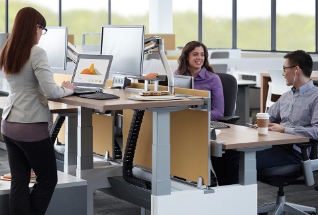A survey conducted recently by furniture retail giant, Steelcase, and research firm, Ipsos, queried workers all over the world on the concept of ‘personal productivity’ as it relates to physical floor plans and layouts and how it impacts them emotionally.
The fact that 90% of those queried stated that they are less satisfied with their workplace environments tells us something.
We’ve reprinted the entire article from Business News Daily below for your information.
Business center and coworking space owners and operators should take note of the five “work modes” identified by Steelcase’s senior advisor and developer of advanced applications. Layout and design components can either encourage or squelch productivity. How does your space stack up?
————————————–
Encouraging Productivity Is All About the Environment
by Nicole Fallon, Business News Daily Assistant Editor
Ever wonder what the secret to employee productivity is? Having the right technology can help, but a lot of it has to do with the work environment.
A recent survey by office furniture retailer Steelcase and research firm Ipsos found that nearly 90 percent of workers around the world are less than satisfied with their work environments, primarily due to a lack of privacy. Open office plans are great for facilitating collaboration and transparency, but they also make privacy and focus a real challenge for today’s workers, said Meg O’Neil, senior designer and developer of advanced applications and marketing at Steelcase.
“Everyone seems to be struggling with [workplace privacy],” O’Neil told Business News Daily. “It’s affecting engagement, performance and [job] satisfaction.”
One of the greatest benefits of a well-designed workspace — and consequently, the option of privacy in the office — is an increase in engagement and productivity among workers. Of the 11 percent of survey respondents who were highly satisfied with their work environments, the majority (88 percent or more) said that their workplace allowed them to concentrate easily, work in teams without being interrupted, choose where to work based on their task, and feel a sense of belonging to the company and its culture.
The last point is perhaps the most important, said Brian Shapland, general manager of Steelcase’s small business brand Turnstone. Employee well-being depends on that sense of belonging, he said.
“Office design for small businesses [should be] focused on allowing employees to feel like they’re a meaningful part of the organization [and its] purpose.” Shapland said. “[When they] walk into the space, make it apparent that the company values them.”
Max Chopovsky, founder of Chicago Creative Space, a company that produces video and media content on office design and culture, agreed: As a small company grows and can afford to invest in a good workspace, the environment should become a tangible manifestation of the company culture, he said. This means collecting input from employees about their ideal work conditions and incorporating that feedback into the workspace.
“Ask employees, ‘When do you do your best work?'” Chopovsky said. “‘What are you doing – sitting, standing, walking?’ Getting those data points allows you to understand how your employees are most productive. Once you have that, it’s a matter of drilling into it and [determining] what you can implement in your space.”
In any office, having a variety of workspaces that are suited to different work styles and tasks is the key to ensuring that every employee can do his or her best work. O’Neil identified five “work modes” that office design should service: focus, collaboration, socialization, learning and rejuvenation. For example, you might want to provide standing desks, couches or bean bag chairs, private conference rooms, rooms with whiteboards, and a kitchen/lounge space to accommodate the various work modes an employee might occupy throughout the day.
“Individually owned workspaces are getting smaller and smaller [with fewer] boundaries, making a series of interdependent spaces in an [office] ecosystem that much more important,” O’Neil said. “It’s important to understand the unique needs of [workers] and what they’re trying to accomplish.”
“It’s not just about one space anymore,” added Katie Pace, a Steelcase spokeswoman. “It’s about looking at the floor plan as a whole and ensuring workers have choice and control over where and how they work.”
For businesses on a budget, Chopovsky advised investing in easy-to-move, modular furniture that can be reconfigured as necessary to allow for different work styles.
Shapland noted that part of the reason a “palate” of workspaces is so effective is because people want to work how they live. Creating spaces that feel a little more like home can help employees feel more relaxed and engaged in the workplace.
“The lines of work and life are blurred,” Shapland said. “People don’t want to check who they are at the door. Employees should feel comfortable being their best selves.”
Image: Steelcase.com


 Dr. Gleb Tsipursky – The Office Whisperer
Dr. Gleb Tsipursky – The Office Whisperer Nirit Cohen – WorkFutures
Nirit Cohen – WorkFutures Angela Howard – Culture Expert
Angela Howard – Culture Expert Drew Jones – Design & Innovation
Drew Jones – Design & Innovation Jonathan Price – CRE & Flex Expert
Jonathan Price – CRE & Flex Expert












